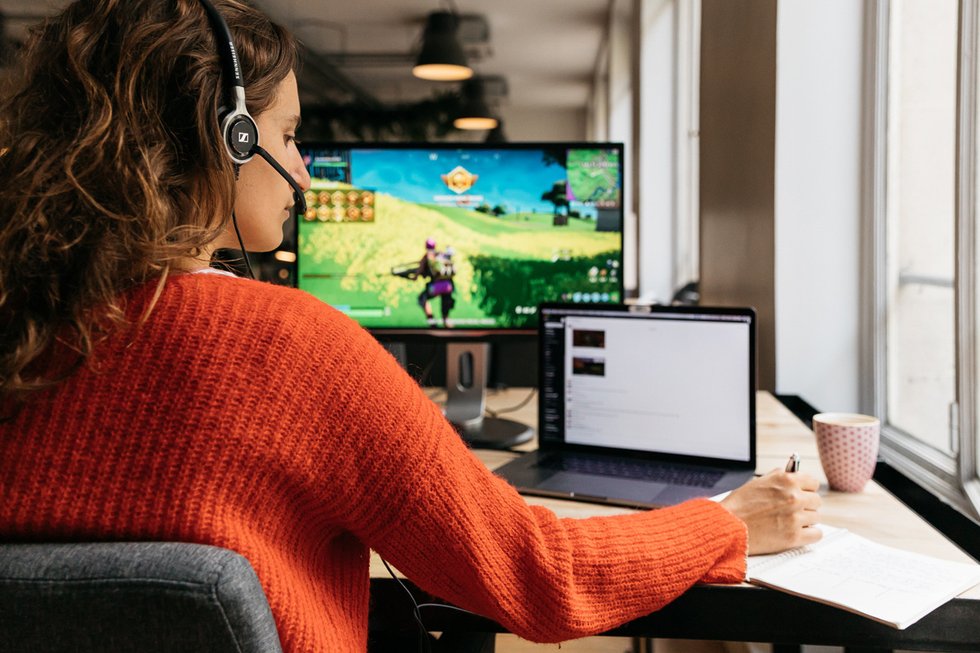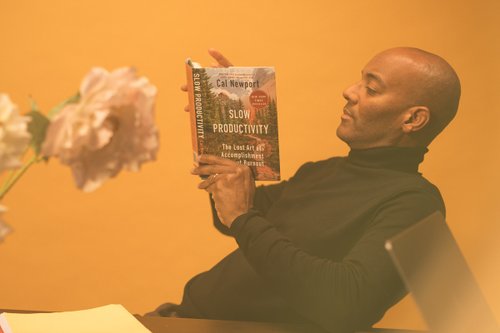Fortnite, Minecraft, Second Life: will meetings all be in video games soon?
Jul 16, 2020
9 mins


Journaliste - Welcome to the Jungle
“Zoom sucks, we started having editorial meetings in Red Dead Redemption instead. It’s nice to sit at the campfire and discuss projects, with the wolves howling out in the night.”
Artist and author Viviane Schwarz probably had no idea when she published this tweet on May 16, 2020, that she would create such a buzz: her post quickly garnered hundreds of comments and more than 100,000 likes. That’s because, as gamers know, Red Dead Redemption is a multiplayer adventure video game set in the Wild West. As we were still on lockdown when she posted her tweet, the idea of meeting up with colleagues in a video game appealed to many internet users: “It’s the best thing I’ve ever read on Twitter,” “On Monday, I’m buying Red Dead Redemption for my entire team,” were just some of the comments.
This tweet may seem more likely to make you smile than to revolutionize the world of work, but it poses a real question: now that working from home has become more common, could we meet and communicate with our colleagues in virtual companies in the future? Second Life, Minecraft, Fortnite, Animal Crossing, Red Dead Redemption, World of Warcraft––is it really absurd to think that one day these games could hold our meeting rooms? To find out, we’ve been investigating and experimenting.
The origins: the success of Second Life
Everything changed during the lockdown when events were held inside video games. Travis Scott gave a psychedelic concert on Fortnite, an online shooting game where the goal is to be among the last survivors of a batch of 100 players. Fashion brands such as Valentino, Marc Jacobs, and Gemo organized shows in the child-like and innocent universe of Animal Crossing, a game where the player moves to an island inhabited by animals. The professional world has not ignored the trend either. At least one Japanese company has held a meeting in Animal Crossing. Innovative? Not really! The desire to move professional life into video games isn’t new.
In the 2000s, Second Life (SL) was considered a technological gem. The concept is simple: it provides an infinite, 3D world in which everyone can create their own avatar, interact with other players, and even buy goods such as furniture, clothes, or coffee. Yes, for real, with real money. It is the ultimate metaverse: a virtual world where users can interact freely with other users and businesses.
Second Life quickly benefited from strong coverage in the media and a buzz built up around the product. It was going to revolutionize our professional and personal lives, according to articles published at the time. So it didn’t take long before companies decided to invest in the game in the hopes of getting ahead of the curve. In 2010, IBM even created its own virtual space there. At that time, 6,000 employees from the multinational already had their own avatars in the metaverse. So what did IBM hope to achieve? To be able to secure certain company data, promote knowledge-sharing between employees, facilitate training, and organize international events at a lower cost.
But the “miracle” game did not achieve the expected heights of success and little by little the media lost interest. The wind left its sails and companies deserted it. Now 17 years after its creation, you can still find a handful of loyal followers. To be frank, they are often looking for partners for online sex games as the sex industry is very present in Second Life. (There’s nothing very corporate in that, is there?)
The virtual world continued quietly for a decade until the lockdown happened and usage began to surge. Video games have been downloaded and played in record numbers during the pandemic. Are gamers working remotely in these spaces? Probably. “Obviously there are lots of great tools, like Zoom, or Skype, or Google Hangouts,” said Ebbe Altberg, the chief executive of Linden Lab, the game’s publisher, in a recent interview with Skift, “but we provide a way for people to be more immersed in the experience, and to be able to create environments that make meetings, or events, of all kinds more interesting than just looking at people’s faces from webcams.” So, is this a sign that the corporate world is interested in gaming again? And is it ready to take full advantage of its possibilities?

IBM on Second Life
The promises of a virtual world
At first glance, the idea of meeting up with your colleagues in a video game may seem bizarre. Yet there are signs that it could happen faster than initially believed.
Inclusiveness: at the heart of the debate
The fight against discrimination in the workplace is growing each year and the metaverse might be able to help with inclusiveness. In video games–-unlike the “real life” world of work––all avatars are born equal. You typically begin with a starter pack, then you progress, learn, and evolve based on merit. There is no inequality, no privilege, and no judgment. So, whether we see our colleagues in a game sometimes or whether our professional relationship is exclusively virtual, it could be a way for some to feel more confident and free from how others may perceive you. This is what Hugues Ouvrard, the then director of Xbox France, said to Le Monde in 2017: “Online, we often forget who the person in front of us is, what their age, gender, and abilities are.” This came after he met Hichem, a young man with a disability, who uses his feet to play video games.
Ecology: more important than ever
At a time when UK employees are speaking up on climate change in the workplace more than ever before, this question is increasingly important: Wouldn’t it be appropriate to relocate meetings to less-polluting virtual locations such as those in video games? Business air travel has an environmental cost as well as a financial one. A long-haul return flight from London to Perth contributes more than 3,000kg of CO2 per person, but a one-hour meeting on an Xbox 360, the most-polluting console, would produce closer to 270 grams of CO2. The PS5 is estimated to generate hourly emissions of just 0.02kg of CO2 equivalent per hour. Of course, videoconferencing applications such as Zoom or Hangouts are even less harmful to the environment, though perhaps less immersive.
Working remotely is becoming common
Almost a third of the UK workforce plans to continue to work from home after lockdown, with three in 10 saying they will do so purely for environmental reasons, according to a survey of 3,000 adults. If the geographical gap between employees and their company really is widening, then the metaverse could be useful in helping telecommuters to stay in touch, beyond the traditional face-to-face meetings, especially in informal gatherings or breaks. Some companies took the plunge during the lockdown, replicating their desktops virtually by creating lounges for each member of the company and each team via Discord, a voice chat software originally designed for gaming communities.
But then what would be the added value for employees compared to traditional applications such as Zoom and Skype?
The experience
Since anything worth doing is worth doing yourself, we tested the concept here at Welcome to the Jungle. We didn’t virtually replicate our offices, nor did we create avatars for all the employees, but we set up our home, or rather our meeting, in a video game. The goal: to determine whether this futuristic-looking way of working has any real added value compared to the traditional video tools. Could it, for example, make us more creative, more productive, or bring us closer? After comparing a dozen online games, we ventured to the lush, cubist world of Minecraft. Why this game? Because it’s easy to protect yourself, (getting killed by a zombie right in the middle of the boss’s presentation isn’t ideal) but also because the world of Minecraft seemed to us to be conducive to creativity: the goal is to create an entire civilization from scratch.
First mission: Prepare
Organizing this meeting was a proper obstacle course. The logistics took up a lot of our time. The volunteers either didn’t have enough time to devote to the experience, or they didn’t have enough space on their computers to host the game––or both. The end result was that, while we had planned to try it out with at least five people, we ended up with just three. That was not a great start, but it didn’t matter. We then scheduled an hour of play to “brainstorm”. Then, we created a structure for the meeting by preparing a list of questions we wanted to answer.
Second mission: Build a shelter
In Minecraft, players can roam freely around the world during the day, but at night monsters show up to attack them. So you have to start by building a shelter. We started building our meeting room. The game quickly took on a team-building feel. We communicated what we were doing (“I’m going to loot to get some wood on my end”) while swapping tools (“Does anyone have an axe?”) and gameplay tips (“Why does it shoot out a flower when I want to put down a block of wood?”). In less than 10 minutes, our office was built.

Our team in Minecraft
Third mission: Brainstorm
After dark, we went home to shelter from the monsters. That’s when the meeting really got going. We had been brainstorming around the fire for only a minute, when the players, distracted and engrossed in the game, went back to their activities. The meeting facilitator (ie me) found herself alone in front of the fire. So I followed them to explore the world. All in all, we brainstormed on a boat, watching turtles underwater and while fighting monsters. You have to admit, it’s a lot more exciting than a Zoom window. After an hour of play, the meeting ended with a giant spider killing my two colleagues. A much more original exit than an embarrassed “bye” to the camera.

Our team in Minecraft
The results: somewhere between inspiration and lack of focus
Professional relationships in turmoil
The most obvious difference from a videoconference meeting is the relationship with our colleagues. When we meet up with others in video games, they’re usually our friends. So, when we are immersed in this parallel world, our professional relationships are transformed into something more like friendship. No managers were present at the meeting, but if they had been, any sort of hierarchy would have been swept away by the warm and informal atmosphere of the game.
Easier to speak, but less focus
While we were busy building objects and walking around, we felt it was easier to speak up, explain our ideas, and have a real discussion. Maybe that’s because the game is less intimidating than a Zoom meeting? Or maybe because we didn’t feel like we were working? Either way, the video game seemed to take some pressure off of our shoulders. On the other hand, even if we felt we were better speakers, we were much less attentive to what others were saying: we had to ask our colleagues to repeat themselves more often than in a traditional meeting.
More creativity, but surface-level thinking
It’s hard to say whether this meeting format made us more creative, but it’s certain that keeping our fingers busy looting (retrieving objects in a video game), walking, running, swimming, and building let our minds wander. It’s a bit like driving a car and, in that state of intense concentration, getting lost in your thoughts. On the other hand, since our main activity was playing a game, we felt much less obligated to fill in the blanks, and we didn’t bother going in-depth with certain thoughts. We agreed with one another on all the issues but felt that we hadn’t gotten into them in enough depth.
The table-football effect
So the real question is: is it worth it? It’s not clear. Meeting up with your colleagues in a video game can be fun for brainstorming, for a team-building exercise, or even for training, but it is probably not worth using for meetings where you have to delve into documents and need to be particularly focused. Obviously, Minecraft has not been designed (as of yet?) to organize meetings, and the experience would certainly have been different on a more suitable metaverse such as Second Life. But still, this meeting was not as conclusive as we had imagined it would be, especially in light of the testimonials circulating on this subject.
Having finished the experiment, we can’t help wondering if the real motivation of companies using video games as a means of communication is to improve their image rather than their productivity. What if building a virtual company in a video game looked good, but was not really useful? If this trend takes off, it could become a recruitment tool for companies, an argument for strengthening their brand as an employer. What if saying to future employees: “We have a hub in a video game” becomes the equivalent of “We have table football”? At a time when the job market is experiencing a severe shortage of tech talent, wouldn’t say the company being involved in a video game be a hidden way of attracting more developers and other fans of innovation? Only time will tell.
One thing’s for sure: while the prospect of maintaining a professional life in a virtual world may seem futuristic, if not downright inconceivable, many gaming companies are already looking into the idea. In December 2019, a Twitter user asked Tim Sweeney, the chief executive of Epic Games, whether he considered Fortnite to be a video game. He said: “Fortnite is a game. But please ask that question again in 12 months.” If a metaverse that is sufficiently engaging, immersive, unifying, and accessible is created tomorrow, it’s highly likely that the business world will be very interested in it.
Translated by Kalin Linsberg
Photo: Welcome to the Jungle
Follow Welcome to the Jungle on Facebook, LinkedIn, and Instagram, and subscribe to our newsletter to get our latest articles every day!

More inspiration: Future of Work

The Bear: When professional passion turns toxic
Carmy's workplace trauma isn't unique...
Dec 31, 2024

The youth have spoken: South Korea’s push for a four-day workweek
Is this the end of Korean hustle culture?
Dec 26, 2024

Cal Newport's Slow Productivity: Redefining success in a hustle culture
Is slowing down the key to achieving more?
Dec 19, 2024

Wellbeing washing: Are workplace mental health apps doing more harm than good?
Workers are struggling with mental health. Are employers approaching it the right way?
Dec 19, 2024

Dark side of DINKs: Working as a childfree adult
Having children comes with challenges. So does choosing not to.
Dec 11, 2024
Inside the jungle: The HR newsletter
Studies, events, expert analysis, and solutions—every two weeks in your inbox

